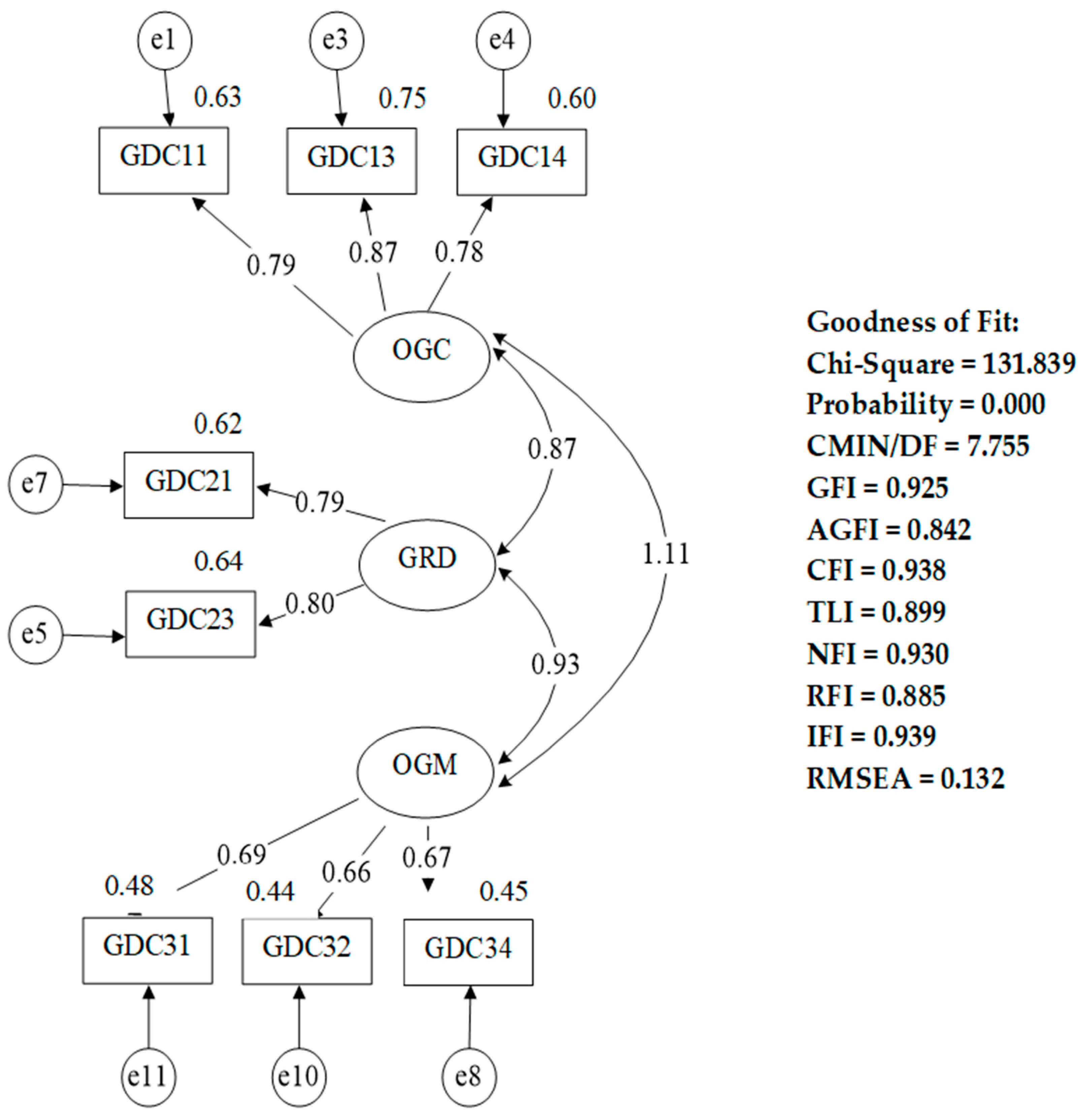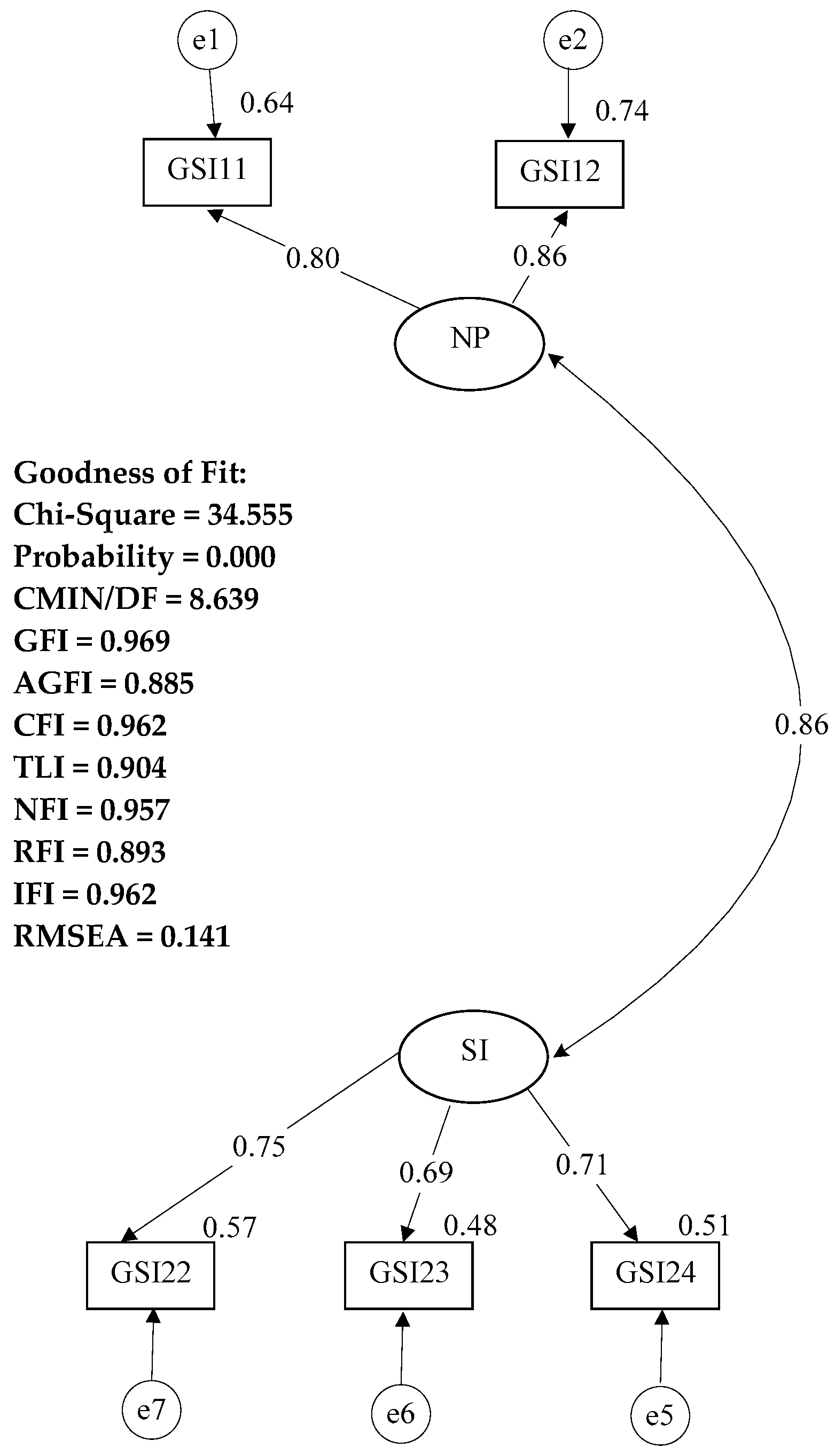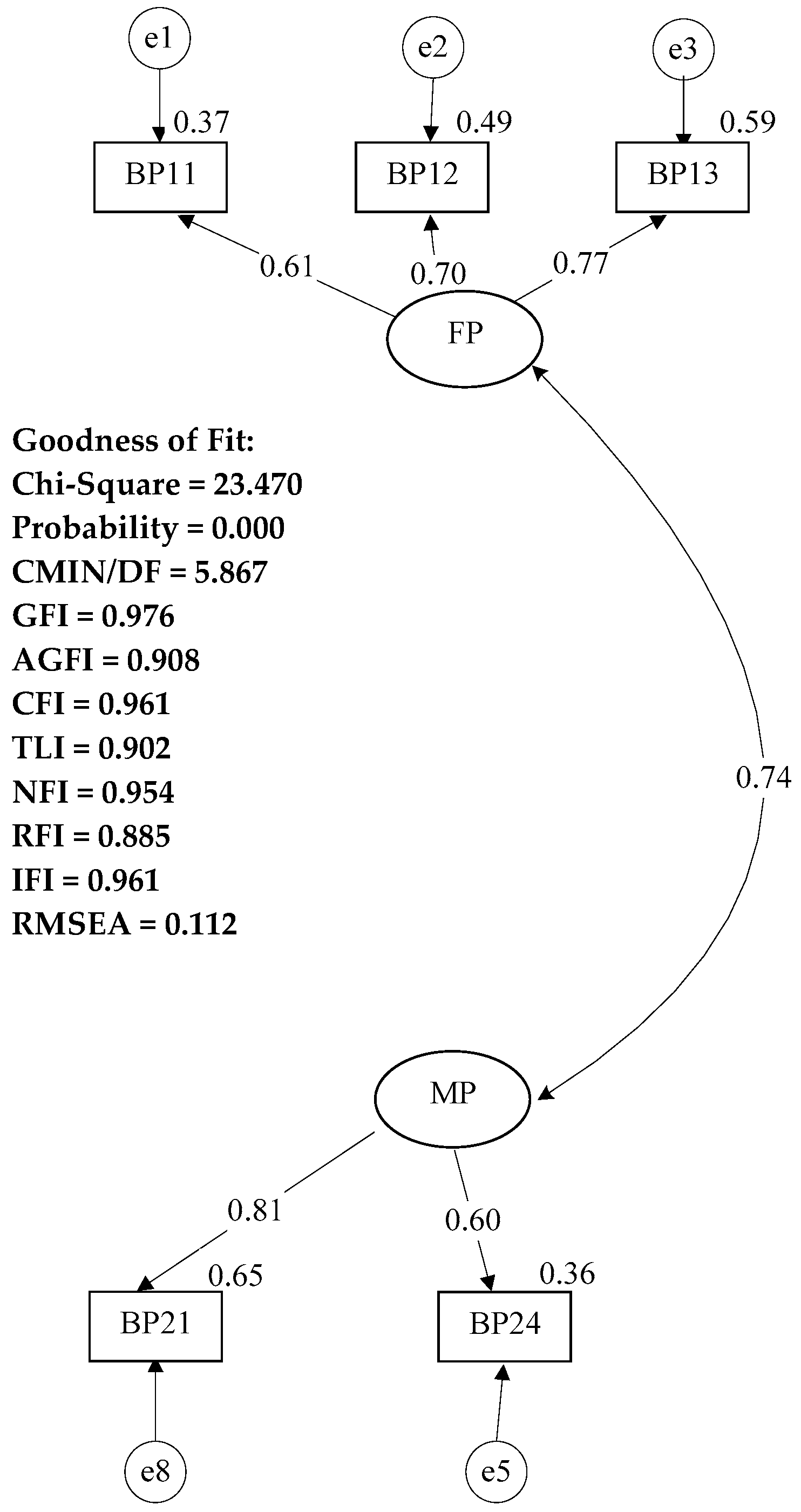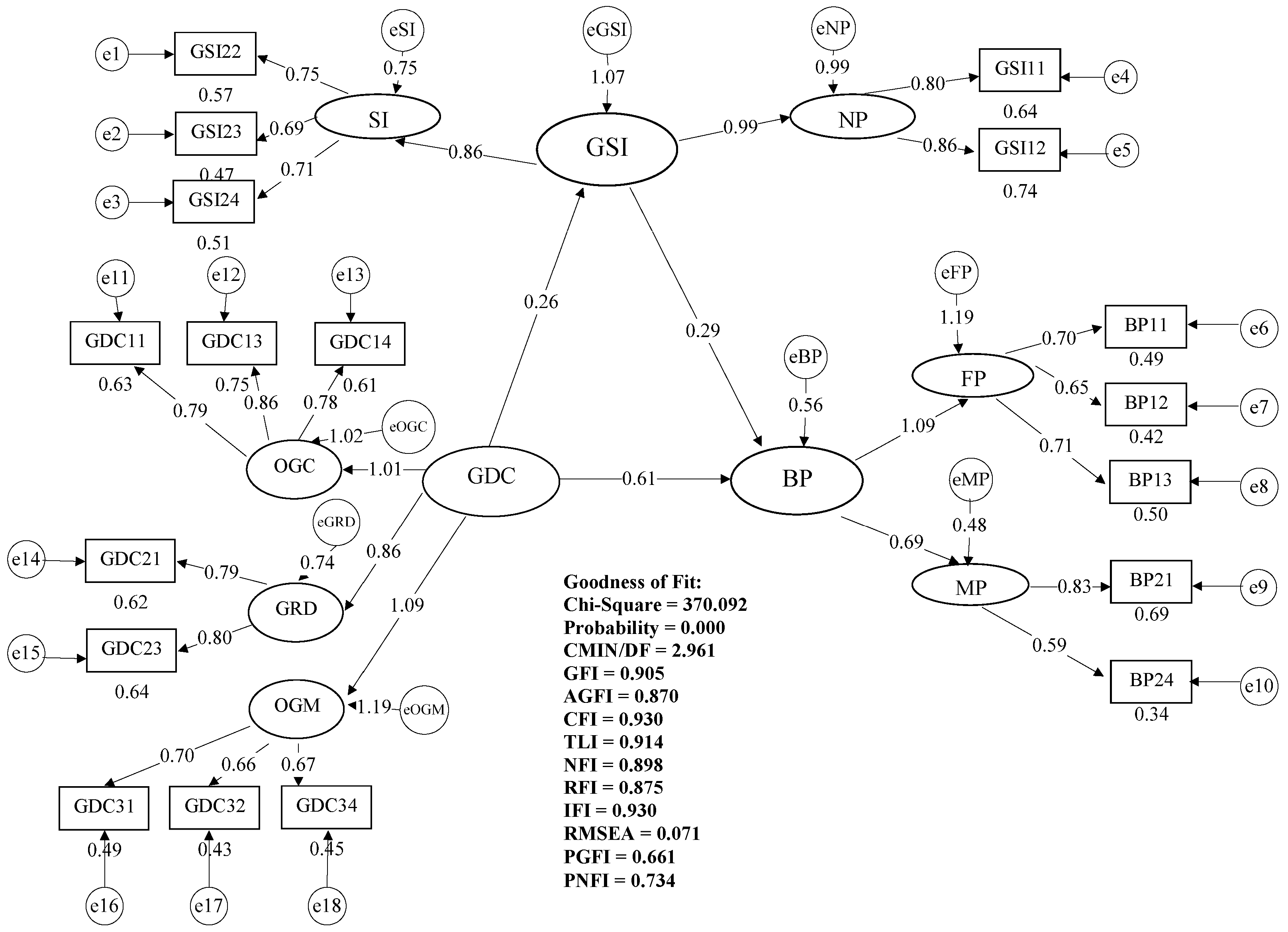Harnessing Green Dynamic Capabilities for Sustainable Tourism Performance: The Mediating Role of Green Service Innovation in Bali’s Tour and Travel SMEs
Abstract
1. Introduction
2. Literature Review
2.1. Green Dynamic Capabilities
2.2. Green Service Innovation
2.3. Business Performance
3. Research Hypotheses
3.1. Green Dynamic Capabilities and Green Service Innovation
3.2. Green Dynamic Capabilities and Business Performance
3.3. Green Service Innovation and Business Performance
3.4. Mediating Role of Green Service Innovation
4. Materials and Methods
4.1. Data Collection
4.2. Measurement Development
5. Analysis and Results
5.1. Assessment of the Measurement Model
5.2. Assessment of the Structural Model
6. Discussion and Conclusions
6.1. Theoretical Implications
6.2. Practical Implications
6.3. Limitations and Future Research
Author Contributions
Funding
Institutional Review Board Statement
Informed Consent Statement
Data Availability Statement
Conflicts of Interest
Appendix A
| Construct | Dimension | Items |
|---|---|---|
| Green dynamic capabilities | Organizational green strategic capability | Q1: I possess competitive flexibility capabilities. |
| Q2: The knowledge of our tour and travel employees aligns with the company’s vision and mission. | ||
| Q3: I possess entrepreneurial characteristics. | ||
| Q4: I have the ability to recognize business opportunities or threats. | ||
| R&D green innovation capability | Q5: I am able to evaluate the strengths and weaknesses of the company. | |
| Q6: I am able to develop new environmentally friendly products or services. | ||
| Q7: I have a clear direction and dedicated time allocation for conducting environmentally friendly research and development initiatives. | ||
| Organizational green management capability | Q8: I am able to communicate and coordinate effectively with business partners. | |
| Q9: I am able to coordinate with the community to meet shared needs. | ||
| Q10: I am able to balance work, family life, and leading employees effectively. | ||
| Q11: I am able to understand customer needs. | ||
| Green service innovation | New practices | Q1: Our tour and travel business introduces new environmentally conscious practices in selling tour packages and services. |
| Q2: Our tour and travel business introduces new environmentally conscious practices in serving customers. | ||
| Q3: Our tour and travel business introduces new environmentally conscious practices in internal operations and administration. | ||
| Q4: Our tour and travel business introduces new environmentally conscious practices in internal operations and administration. | ||
| Service improvement | Q5: Our tour and travel business improves and enhances environmentally based tour packages and services. | |
| Q6: Our tour and travel business repackages environmentally based tour packages and services. | ||
| Q7: Our tour and travel business provides environmentally conscious after-sales services. | ||
| Q8: Our tour and travel business provides environmentally conscious after-sales services. | ||
| Business performance | Financial performance | Q1: Over the past two years, our tour and travel sales have increased. |
| Q2: Over the past two years, our tour and travel revenue has increased. | ||
| Q3: Over the past two years, the number of our tour and travel customers has increased. | ||
| Q4: Over the past two years, there has been an overall improvement in our financial performance. | ||
| Business performance | Market performance | Q5: Our tour and travel business has entered new markets more quickly than our competitors. |
| Q6: Our tour and travel business has introduced new products/services more quickly than our competitors. | ||
| Q7: The success rate of our tour and travel business in introducing new products/services is higher than that of our competitors. | ||
| Q8: Our tour and travel market share has increased over the past two years. |
References
- Abrudan, D., Kalyar, M. N., & Daianu, D. C. (2024). Demystifying the effects of organizational sensemaking and green dynamic capabilities on sustainability performance. Engineering Economics, 35(3), 348–361. [Google Scholar] [CrossRef]
- Aftab, J., Abid, N., Sarwar, H., Amin, A., Abedini, M., & Veneziani, M. (2023). Does corporate social responsibility drive financial performance? Exploring the significance of green innovation, green dynamic capabilities, and perceived environmental volatility. Corporate Social Responsibility and Environmental Management, 31(3), 1634–1653. [Google Scholar] [CrossRef]
- Ahmed, R. R., Akbar, W., Aijaz, M., Channar, Z. A., Ahmed, F., & Parmar, V. (2023). The role of green innovation on environmental and organizational performance: Moderation of human resource practices and management commitment. Heliyon, 9(1), e12679. [Google Scholar] [CrossRef] [PubMed]
- Almeida, F., & Wasim, J. (2022). Eco-innovation and sustainable business performance: Perspectives of SMEs in Portugal and the UK. Society and Business Review, 18(1), 28–50. [Google Scholar] [CrossRef]
- Ariyanto, A. (2022). Green tourism management for sustainable tourism development in the age of disruption. Jurnal Multidisiplin Sahombu, 2(1), 23–28. [Google Scholar] [CrossRef]
- Bari, N., Chimhundu, R., & Chan, K. C. (2024). Interrelation between sustainable dynamic capabilities, corporate sustainability, and sustained competitive advantage. Sustainability, 16(7), 2864. [Google Scholar] [CrossRef]
- Borah, P. S., Dogbe, C. S. K., & Marwa, N. (2024). Green dynamic capability and green product innovation for sustainable development: Role of green operations, green transaction, and green technology development capabilities. Corporate Social Responsibility and Environmental Management, 32(1), 911–926. [Google Scholar] [CrossRef]
- Bozdaglar, H. (2023). The use of sustainable tourism certification programs and their impact on the sustainability of tourism development: Evidence from North Cyprus. International Journal of Science and Management Studies (IJSMS), 6(1), 296–300. [Google Scholar] [CrossRef]
- Bresciani, S., Rehman, S. U., Alam, G. M., Ashfaq, K., & Usman, M. (2022). Environmental mcs package, perceived environmental uncertainty and green performance: In green dynamic capabilities and investment in environmental management perspectives. Review of International Business and Strategy, 33(1), 105–126. [Google Scholar] [CrossRef]
- Buzzao, G., & Rizzi, F. (2020). On the conceptualization and measurement of dynamic capabilities for sustainability: Building theory through a systematic literature review. Business Strategy and the Environment, 30(1), 135–175. [Google Scholar] [CrossRef]
- Byrne, B. M. (2016). Structural equation modeling with AMOS: Basic concepts, aplications, and programming. Routledge Taylor & Francis Group. [Google Scholar]
- Chatterjee, S., Chaudhuri, R., Vrontis, D., & Chaudhuri, S. (2022). The impact of dynamic capability on business sustainability of organizations. Fiib Business Review, 11(4), 455–467. [Google Scholar] [CrossRef]
- Chen, L., Yuan, M., Lin, H., Han, Y., Yu, Y., & Sun, C. (2023). Organizational improvisation and corporate green innovation: A dynamic capability perspective. Business Strategy and the Environment, 32(8), 5686–5701. [Google Scholar] [CrossRef]
- Cong, P. T. (2023). The role of knowledge management and green innovation in sustainable performance. Irasd Journal of Management, 5(3), 161–176. [Google Scholar] [CrossRef]
- Correia, R. J., Dias, J. G., & Teixeira, M. S. (2020). Dynamic capabilities and competitive advantages as mediator variables between market orientation and business performance. Journal of Strategy and Management, 14(2), 187–206. [Google Scholar] [CrossRef]
- Dang, V. T., Vo-Thanh, T., Wang, J., & Nguyen, N. (2023). Luxury hotels’ green practices and consumer brand identification: The roles of perceived green service innovation and perceived values. Business Strategy and the Environment, 32(7), 4568–4583. [Google Scholar] [CrossRef]
- Duarte, M., Dias, Ã., Sousa, B., & Pereira, L. (2023). Lifestyle entrepreneurship as a vehicle for leisure and sustainable tourism. International Journal of Environmental Research and Public Health, 20(4), 3241. [Google Scholar] [CrossRef]
- Elf, P., Werner, A., & Black, S. (2022). Advancing the circular economy through dynamic capabilities and extended customer engagement: Insights from small sustainable fashion enterprises in the UK. Business Strategy and the Environment, 31(6), 2682–2699. [Google Scholar] [CrossRef]
- Gamero, M. D. L., Azorí, J. F. M., Tarí, J. J., & Moliner, J. P. (2024). Identifying the role of absorptive capacity in the relationship between quality management and sustainability: Evidence from the tourism industry. Corporate Social Responsibility and Environmental Management, 32(1), 325–340. [Google Scholar] [CrossRef]
- Hadi, P. (2023). Improving firm sustainability through dynamic capability: The mediation role of ambidexterity. International Journal of Professional Business Review, 8(5), e01511. [Google Scholar] [CrossRef]
- Hair, J. F., Black, W. C., Babin, B. J., & Anderson, R. E. (2019). Multivariate data analysis (8th ed.). Wiley. [Google Scholar] [CrossRef]
- Hair, J. F., Hult, T. M., Ringle, C. M., Sarstedt, M., Danks, N. P., & Ray, S. (2021). Partial least squares structural equation modeling (PLS-SEM). Structural Equation Modeling: A Multidisciplinary Journal, 30(1), 165–167. [Google Scholar] [CrossRef]
- Hoai, T. T., Minh, N. N., Van, H. V., & Nguyen, N. P. (2023). Accounting going green: The move toward environmental sustainability in Vietnamese manufacturing firms. Corporate Social Responsibility and Environmental Management, 30(4), 1928–1941. [Google Scholar] [CrossRef]
- Huang, S., Tian, H., & Cheablam, O. (2023). Promoting sustainable development: Multiple mediation effects of green value co-creation and green dynamic capability between green market pressure and firm performance. Corporate Social Responsibility and Environmental Management, 31(2), 1063–1078. [Google Scholar] [CrossRef]
- Imran, M., Arshad, I., & Ismail, F. (2021). Green organizational culture and organizational performance: The mediating role of green innovation and environmental performance. Jurnal Pendidikan IPA Indonesia, 10(4), 515–530. [Google Scholar] [CrossRef]
- Kerdpitak, C. (2021). The relationship between CRM strategy and customer satisfaction in rice business in north-eastern Thailand. Journal of Southwest Jiaotong University, 56(2), 430–442. [Google Scholar] [CrossRef]
- Khan, F., Sheikh, A. A., & Abbas, S. A. (2023). The the interplay of tactical green marketing orientation and service innovation capability on sustainable business performance. NUML International Journal of Business & Management, 18(1), 1–25. [Google Scholar] [CrossRef]
- Li, C., Hassan, H., Murad, M., & Mirza, F. (2023). Role of green dynamic capabilities on environmental and social innovation behavior: Mediating of green creativity and moderating of innovation proclivity. Sustainability, 15(20), 14996. [Google Scholar] [CrossRef]
- Li, X., Abbas, J., Dongling, W., Baig, N. U. A., & Zhang, R. (2022). From cultural tourism to social entrepreneurship: Role of social value creation for environmental sustainability. Frontiers in Psychology, 13, 925768. [Google Scholar] [CrossRef]
- Lin, Y. H., & Chen, H. C. (2017). Critical factors for enhancing green service innovation: Linking green relationship quality and green entrepreneurial orientation. Journal of Hospitality and Tourism Technology, 9(2), 188–203. [Google Scholar] [CrossRef]
- Long, S., & Liao, Z. (2021). Are fiscal policy incentives effective in stimulating firms’ eco-product innovation? The moderating role of dynamic capabilities. Business Strategy and the Environment, 30(7), 3095–3104. [Google Scholar] [CrossRef]
- Luu, T. T. (2022). Fostering green service innovation perceptions through green entrepreneurial orientation: The roles of employee green creativity and customer involvement. International Journal of Contemporary Hospitality Management, 34(7), 2640–2663. [Google Scholar] [CrossRef]
- Makgopa, S. S. (2023). Towards a conceptual model of measuring the influence of service innovation on business performance. International Journal of Multidisciplinarity in Business and Science, 9(14), 24–32. [Google Scholar] [CrossRef]
- Makhloufi, L., Djermani, F., & Meirun, T. (2023). Mediation-moderation model of green absorptive capacity and green entrepreneurship orientation for corporate environmental performance. Management of Environmental Quality an International Journal, 35(1), 139–157. [Google Scholar] [CrossRef]
- Mbowe, W. (2024). Entrepreneurship mentoring programme and market performance: Evidence from SIDO supported micro and small enterprises in Arusha, Tanzania. Journal of Research Innovation and Implications in Education, 8, 69–79. [Google Scholar] [CrossRef]
- Megawati, S., Herdiansyah, H., Machmud, A., Antriyandarti, E., & Sudirman, S. (2024). Integrating circular economy, digital economy, and social protection policies to drive green business innovation: Insights from Indonesia’s culinary SMEs. Problems and Perspectives in Management, 22(4), 368–381. [Google Scholar] [CrossRef]
- Ndegwa, M. R., Kibera, F., Munyoki, J. M., & Njihia, J. (2020). The moderating influence of competitive environment on the relationship between marketing mix strategies and performance of tour firms in Kenya. International Business & Economics Studies, 2(4), 15. [Google Scholar] [CrossRef]
- Nguyen, T. Q. T., & Hoàng, T. T. H. (2023). Stakeholder involvement and the attainment of SDGs at local tourism destinations. Tourism, 71(3), 432–446. [Google Scholar] [CrossRef]
- Phong, V. T., & Tam, V. T. (2024). The Impact of dynamic capabilities on performance of small and medium tourism businesses: A study for the South-Central Coast Region, Vietnam. Open Journal of Business and Management, 12(01), 444–471. [Google Scholar] [CrossRef]
- Prester, J. (2023). Operating and dynamic capabilities and their impact on operating and business performance. Sustainability, 15(20), 15181. [Google Scholar] [CrossRef]
- Ramadhan, A., & Widiastuty, E. (2023). The influence of environmental, social, governance (esg) and green innovation on company business performance. JFBA Journal of Financial and Behavioural Accounting, 3(2), 48–60. [Google Scholar] [CrossRef]
- Rashid, A. (2024). Conservation of resources for sustainable performance in tourism. Journal of Tourism Management Research, 11(1), 123–139. [Google Scholar] [CrossRef]
- Ridho, H. (2024). Innovative sustainable business model: A case study of eco-tourism in Bukit Lawang. IOP Conference Series Earth and Environmental Science, 1352(1), 12026. [Google Scholar] [CrossRef]
- Silva, L. D. (2024). Tourism and the United Nations sustainable development goals. Applied Tourism, 9(2), 1–12. [Google Scholar] [CrossRef]
- Singh, S. K., Del Giudice, M., Jabbour, C. J. C., Latan, H., & Sohal, A. S. (2022). Stakeholder pressure, green innovation, and performance in small and medium-sized enterprises: The role of green dynamic capabilities. Business Strategy and the Environment, 31(1), 500–514. [Google Scholar] [CrossRef]
- Skordoulis, M., Kyriakopoulos, G. L., Ntanos, S., Galatsidas, S., Arabatzis, G., Chalikias, M., & Kalantonis, P. (2022). The mediating role of firm strategy in the relationship between green entrepreneurship, green innovation, and competitive advantage: The case of medium and large-sized firms in Greece. Sustainability, 14(6), 3286. [Google Scholar] [CrossRef]
- Sukaris, Hartini, S., Mardhiyah, D., Suwardana, H., & Baskoro, H. (2021). Rural tourism sustainable business performance: Dynamic capability perspective. Atlantis Press. [Google Scholar] [CrossRef]
- Tariq, S. (2023). The effect of green HRM practices on green competitive advantage of the SME sector of KSA. Global Journal of Economic and Business, 13(3), 274–284. [Google Scholar] [CrossRef]
- Tjahjadi, B., Agastya, I. B. G. A., Soewarno, N., & Adyantari, A. (2022). Green human capital readiness and business performance: Do green market orientation and green supply chain management matter? Benchmarking an International Journal, 30(10), 3884–3905. [Google Scholar] [CrossRef]
- Tjahjadi, B., Soewarno, N., & Gunawan, G. M. (2020). Effect of information capital readiness on business performance in Indonesian MSMEs: Does online market orientation matter? Journal of Asian Finance Economics and Business, 7(12), 267–274. [Google Scholar] [CrossRef]
- Wang, M., & Liu, Z. (2022). How do green innovation strategies contribute to firm performance under supply chain risk? Evidence from China’s manufacturing sector. Frontiers in Psychology, 13, 894766. [Google Scholar] [CrossRef]
- Wu, W., Wu, W., Wu, K., Ding, C., & Fan, C. (2022). Green innovation, corporate environmental ethics, and competitive advantages of Chinese automobile industry during COVID-19: Corporate environmental management as moderator. Frontiers in Psychology, 13, 832895. [Google Scholar] [CrossRef]
- Yuniarti, R., Soewarno, N., & Isnalita. (2022). Green Innovation on firm value with financial performance as mediating variable: Evidence of the mining industry. Asian Academy of Management Journal, 27(2), 41–58. [Google Scholar] [CrossRef]
- Zhang, J., Ouyang, Y., Philbin, S. P., Zhao, X., Ballesteros-Pérez, P., & Li, H. (2020). Green dynamic capability of construction enterprises: Role of the business model and green production. Corporate Social Responsibility and Environmental Management, 27(6), 2920–2940. [Google Scholar] [CrossRef]
- Zhu, L., & Wang, X. (2023). Green innovation in educational institutes of China: Mediating role of green value co-creation. Engineering Economics, 34(1), 89–102. [Google Scholar] [CrossRef]
- Zhu, Y., Zhang, H.-F., Siddik, A. B., Zheng, Y., & Sobhani, F. A. (2023). Understanding corporate green competitive advantage through green technology adoption and green dynamic capabilities: Does green product innovation matter? Systems, 11(9), 461. [Google Scholar] [CrossRef]





| Variable | Category | Frequency | Percentage (%) |
|---|---|---|---|
| Gender | Male | 279 | 72 |
| Female | 108 | 28 | |
| Generation | Baby boomers | 0 | 0 |
| X | 151 | 39 | |
| Millennials | 236 | 61 | |
| Z | 0 | 0 | |
| Education | Master’s | 81 | 21 |
| Bachelor’s | 263 | 68 | |
| Associate’s | 43 | 11 | |
| Work experience | <3 years | 0 | 0 |
| 3–5 years | 255 | 66 | |
| 6–10 years | 120 | 33 | |
| >10 years | 12 | 3 | |
| Duration of business | <6 years | 0 | 0 |
| Operation | 6–10 years | 89 | 23 |
| 11–20 years | 139 | 36 | |
| >20 years | 159 | 41 | |
| Length of time | <3 years | 0 | 0 |
| Managing business | 3–5 years | 19 | 5 |
| 6–10 years | 163 | 42 | |
| 11–20 years | 116 | 30 | |
| >20 years | 89 | 23 | |
| Number of employees | 0–5 peoples | 0 | 0 |
| 6–19 peoples | 105 | 27 | |
| 20–99 peoples | 282 | 73 | |
| >99 peoples | 0 | 0 | |
| Total sales | <IDR 300 million | 0 | 0 |
| IDR 300 million–2.5 billion | 105 | 27 | |
| IDR 2.5 billion–50 billion | 282 | 73 | |
| >IDR 50 billion | 0 | 0 |
| Construct | Dimension | Items | SFL | AVE | CR | CFI |
|---|---|---|---|---|---|---|
| Green dynamic capabilities | Organizational green strategic capability | GDC11 | 0.793 | 0.799 | 0.969 | 0.938 |
| GDC13 | 0.868 | |||||
| GDC14 | 0.775 | |||||
| R&D green innovation capability | GDC21 | 0.786 | ||||
| GDC23 | 0.802 | |||||
| Organizational green management capability | GDC31 | 0.691 | ||||
| GDC32 | 0.660 | |||||
| GDC34 | 0.673 | |||||
| Green service innovation | New practices | GSI11 | 0.801 | 0.782 | 0.947 | 0.962 |
| GSI12 | 0.858 | |||||
| Service improvement | GSI22 | 0.753 | ||||
| GSI23 | 0.690 | |||||
| GSI24 | 0.711 | |||||
| Business performance | Financial performance | BP11 | 0.610 | 0.694 | 0.918 | 0.961 |
| BP12 | 0.702 | |||||
| BP13 | 0.767 | |||||
| Market performance | BP21 | 0.809 | ||||
| BP24 | 0.600 |
| Goodness of Fit Index | Criteria | Value | Description | |
|---|---|---|---|---|
| Absolute fit indices | Chi square | Low number | 370.092 | Poor fit |
| Probability | >0.05 | 0.000 | Poor fit | |
| CMIN/DF | <2 | 2.961 | Marginal fit | |
| RMSEA | ≤0.08 | 0.071 | Good fit | |
| GFI | ≥0.90 | 0.905 | Good fit | |
| Incremental fit indices | AGFI | ≥0.90 | 0.870 | Marginal fit |
| CFI | ≥0.90 | 0.930 | Good fit | |
| TLI | ≥0.90 | 0.914 | Good fit | |
| NFI | ≥0.90 | 0.898 | Marginal fit | |
| RFI | ≥0.90 | 0.875 | Marginal fit | |
| IFI | ≥0.90 | 0.930 | Good fit | |
| Parsimonious fit indices | PGFI | The bigger, the better | 0.661 | Good fit |
| PNFI | The bigger, the better | 0.734 | Good fit |
| Hypothesis | Relationship | Estimate | S.E. | t-Value | p-Value |
|---|---|---|---|---|---|
| H1 | GDC → GSI | 0.263 | 4.546 | 0.000 | Positive, significant |
| H2 | GDC → BP | 0.612 | 10.545 | 0.000 | Positive, significant |
| H3 | GSI → BP | 0.293 | 5.251 | 0.000 | Positive, significant |
| Hypothesis | Relationship | Estimate | p-Value | Description |
|---|---|---|---|---|
| H4 | GDC → GSI → BP | 0.077 | 0.000 | Positive, significant |
Disclaimer/Publisher’s Note: The statements, opinions and data contained in all publications are solely those of the individual author(s) and contributor(s) and not of MDPI and/or the editor(s). MDPI and/or the editor(s) disclaim responsibility for any injury to people or property resulting from any ideas, methods, instructions or products referred to in the content. |
© 2025 by the authors. Licensee MDPI, Basel, Switzerland. This article is an open access article distributed under the terms and conditions of the Creative Commons Attribution (CC BY) license (https://creativecommons.org/licenses/by/4.0/).
Share and Cite
Elizabeth, E.; Prabowo, H.; Bandur, A.; Setiowati, R. Harnessing Green Dynamic Capabilities for Sustainable Tourism Performance: The Mediating Role of Green Service Innovation in Bali’s Tour and Travel SMEs. Tour. Hosp. 2025, 6, 156. https://doi.org/10.3390/tourhosp6030156
Elizabeth E, Prabowo H, Bandur A, Setiowati R. Harnessing Green Dynamic Capabilities for Sustainable Tourism Performance: The Mediating Role of Green Service Innovation in Bali’s Tour and Travel SMEs. Tourism and Hospitality. 2025; 6(3):156. https://doi.org/10.3390/tourhosp6030156
Chicago/Turabian StyleElizabeth, Elizabeth, Harjanto Prabowo, Agustinus Bandur, and Rini Setiowati. 2025. "Harnessing Green Dynamic Capabilities for Sustainable Tourism Performance: The Mediating Role of Green Service Innovation in Bali’s Tour and Travel SMEs" Tourism and Hospitality 6, no. 3: 156. https://doi.org/10.3390/tourhosp6030156
APA StyleElizabeth, E., Prabowo, H., Bandur, A., & Setiowati, R. (2025). Harnessing Green Dynamic Capabilities for Sustainable Tourism Performance: The Mediating Role of Green Service Innovation in Bali’s Tour and Travel SMEs. Tourism and Hospitality, 6(3), 156. https://doi.org/10.3390/tourhosp6030156







